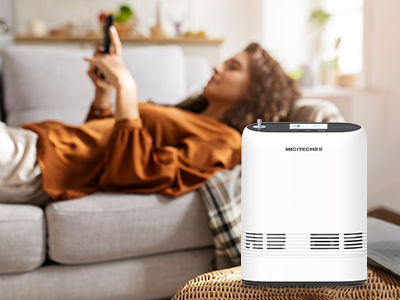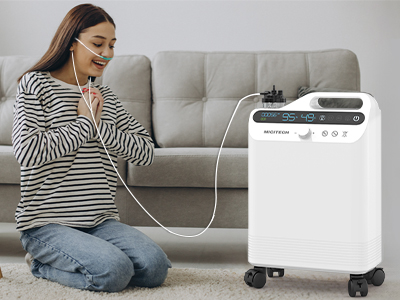26 Apr 2024
Chronic Obstructive Pulmonary Disease (COPD) is a progressive respiratory condition characterized by airflow limitation, which can cause various symptoms that significantly impact a person's quality of life. Oxygen therapy plays a crucial role in the control of COPD symptoms through the operation of an oxygen concentrator, especially when certain symptoms become severe. Here are six symptoms of COPD that require oxygen urgently:

Introduction
A. Overview of COPD
Chronic obstructive pulmonary disease (COPD) is a chronic lung condition characterized by persistent respiratory symptoms and airflow limitation. It encompasses conditions such as emphysema and chronic bronchitis.
B. Importance of Oxygen Therapy
Oxygen therapy is a cornerstone in the management of COPD, especially in advanced stages of the disease. It helps improve oxygenation, relieve symptoms, and enhance the quality of life for COPD patients.
Shortness of Breath (Dyspnea)
A. Definition and Causes
Shortness of breath, also known as dyspnea, is a common symptom of COPD caused by narrowed airways and damaged lung tissue. It can be triggered by physical exertion or occur at rest.
B. Role of Oxygen Therapy
Oxygen therapy helps alleviate dyspnea by providing supplemental oxygen to improve oxygen levels in the blood. This can reduce the workload on the heart and respiratory muscles, making breathing easier for COPD patients.
C. Importance of Managing Dyspnea
Effective management of dyspnea is essential for improving quality of life and preventing exacerbations in COPD patients. Oxygen therapy, along with other interventions such as pulmonary rehabilitation, can help achieve better symptom control.
Chronic Cough
A. Understanding Chronic Cough in COPD
Chronic cough is a hallmark symptom of COPD, resulting from inflammation and irritation of the airways. It can be persistent and bothersome, leading to decreased lung function and impaired quality of life.
B. Impact on Quality of Life
Chronic cough can disrupt daily activities, interfere with sleep, and cause social embarrassment for COPD patients. It is often associated with sputum production and can worsen over time if left untreated.
C. Oxygen Therapy for Alleviating Cough Symptoms
Oxygen therapy can help reduce the frequency and severity of chronic cough by improving oxygenation and reducing airway inflammation. Adequate oxygen levels can also promote healing of damaged lung tissue, leading to symptom relief.

Fatigue
A. Fatigue in COPD Patients
Fatigue is a common and debilitating symptom of COPD that can significantly impair daily functioning and quality of life. It is often related to reduced oxygenation, increased work of breathing, and sleep disturbances.
B. Oxygen Therapy for Energy Boost
Supplemental oxygen therapy can provide an energy boost to COPD patients by increasing oxygen delivery to tissues and organs. This can help reduce fatigue and improve overall stamina and endurance.
C. Managing Fatigue with Proper Oxygenation
Ensuring adequate oxygenation is essential for managing fatigue in COPD patients. Oxygen therapy should be prescribed based on individual oxygen needs to optimize energy levels and enhance quality of life.
Cyanosis (Blue Lips or Fingernails)
A. Significance of Cyanosis in COPD
Cyanosis, characterized by bluish discoloration of the lips, fingertips, or nails, indicates severe oxygen deprivation in the blood. It is a serious symptom that requires prompt medical attention in COPD patients.
B. Oxygen Therapy for Addressing Cyanosis
Supplemental oxygen therapy is the primary treatment for cyanosis in COPD patients. It helps increase oxygen levels in the blood, improving tissue oxygenation and reducing the risk of complications.
C. Importance of Monitoring Oxygen Levels
Regular monitoring of oxygen levels is crucial for COPD patients with cyanosis to ensure they receive adequate oxygen therapy. Adjustments to oxygen flow rates may be necessary to maintain optimal oxygenation and prevent further complications.
Frequent Respiratory Infections
A. Link Between COPD and Respiratory Infections
COPD patients are more susceptible to respiratory infections due to weakened immune function, impaired lung clearance mechanisms, and underlying airway inflammation. These infections can exacerbate COPD symptoms and lead to hospitalization.
B. Role of Oxygen Therapy in Preventing Infections
Oxygen therapy can help prevent respiratory infections in COPD patients by improving immune function and reducing the risk of hypoxemia. Adequate oxygenation supports the body's ability to fight off infections and recover more quickly from illness.
C. Enhancing Immune Function with Proper Oxygenation
Optimizing oxygen levels through supplemental oxygen therapy can enhance immune function and reduce the risk of respiratory infections in COPD patients. It is essential to maintain proper oxygenation to support overall health and well-being.
Difficulty Performing Daily Activities
A. Impact of COPD Symptoms on Daily Functioning
COPD symptoms such as dyspnea, fatigue, and coughing can make it challenging for patients to perform daily activities such as walking, climbing stairs, and household chores. This can lead to decreased independence and lower quality of life.
B. Oxygen Therapy for Improving Activity Tolerance
Supplemental oxygen therapy can improve activity tolerance in COPD patients by reducing breathlessness and increasing oxygen delivery to tissues. This allows patients to engage in more physical activity and maintain their independence.
C. Enhancing Quality of Life Through Oxygen Support
By improving oxygenation and reducing symptom burden, oxygen therapy can enhance the quality of life for COPD patients. It enables them to participate in meaningful activities and enjoy a higher level of functional independence.
Sleep Disturbances
A. Prevalence of Sleep Issues in COPD Patients
Many COPD patients experience sleep disturbances, including insomnia, sleep apnea, and nocturnal hypoxemia. These sleep problems can worsen COPD symptoms and contribute to poor health outcomes.
B. Oxygen Therapy for Managing Sleep Disturbances
Supplemental oxygen therapy can help manage sleep disturbances in COPD patients by improving nighttime oxygenation and reducing the risk of nocturnal hypoxemia. This can lead to better sleep quality and overall well-being.
C. Improving Sleep Quality with Proper Oxygenation
Ensuring adequate oxygenation during sleep is essential for COPD patients to achieve restorative sleep and wake up feeling refreshed. Oxygen therapy can play a crucial role in improving sleep quality and enhancing overall health outcomes.
In conclusion, recognizing the symptoms that urgently require oxygen therapy is essential for effectively managing COPD and improving patient outcomes. By addressing these symptoms with proper oxygenation, healthcare providers can help COPD patients lead healthier and more fulfilling lives.
Keywords: oxygen concentrator
Originally published 26 Apr 2024, updated 26 Apr 2024.